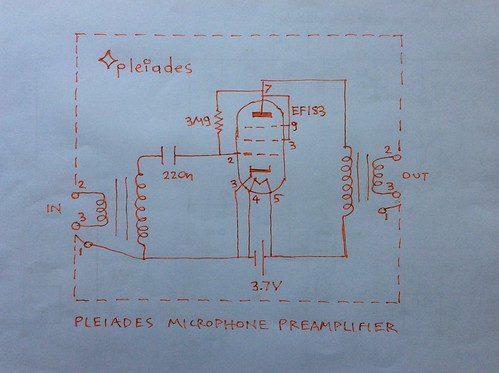Caution: Always use a fuse in series with a battery for safety.
This is a summary of some basic audition tests with mic in real time done before substituting for the first time the 2DV4 Nuvistor electron tube fed by 1.3V from its heaters and plate (anode).
This is the schematic of the Pleiades V6 mic booster amp used in breadboard form on the Pleiades experimental jig:

Cc is 22nF.
Signal path, setup:
Male singing voice - Sennheiser MD441 U3 on table stand - Pleiades V6 front end mic amp with Altec Peerless 4722 inoutbtransformer - Sony TC-D5 Pro mic with phase inverted XLR adaptor, Sony set to mono - Sennehsier HD580
Previous electron tube and supply voltage configurations were tried during about 1 hour so that a meaningful recent sonic memory could exist for comparing the newcomer to the game, Nuvistor 2DV4 electron tube.
1st test:
EF183 supplied with 3.6V at heaters, grid at space potential and anode supplied by 9V,
Big sound.
A joy to hear just a mid frequency air when mic is unplugged. This is typical of free grid. See also Sylvsnia 1H4 Pleiades tests at 9V. When a short circuit (linked 2 to 3 male XLR) is connected HF hiss increases!. When the mic is connected the sense is of a vacuum cleaner sucking everything the mic can give including much of the ambience.
Is is about 25μA.
It is a miracle what just 25μA can do. Well it should be billions billions billions of electrons anyway, passing per second?
There is some bass cut which complements the MD441 U3 when used at less than 8in. At less than 6in if memory is correct the sound started to become bass heavy nevertheless.
In summary, big sound, full spectrum body.
2nd test:
Nuvistor 7586, grid at space potential.
Vb again 9V. Ia too low, approx 4μA.
But it works and the sound is very nice. Less bass heavy so the mic can be further approached. So mic distance can be 4-6in.
Similar oo ohms to 0 ohms noise behaviour.
Test 3:
Nuvistor 7586, grid at space potential, Vb=1.3V
Very quiet sound.
Hiss as loud as voice.
No wonder, Ia is almost nonexistent. This happens because if one measures with an electrometer the grid potential it may be found typical many hundred millivolts negative with respect to cathode ie at cutoff for such low plate voltage. This is possibly because the cathode is positive wrt grid by loosing thermo-emitted electrons.
2 high Megohm resistors where used to pull up the negative grid bias. 18MΩ? from anode to grid.
Much better, louder sound.
Is Ia 1μA? Hard to see if the needle is moving at all.
The sound is kind of treble HF sound.
So mic can be used at 2-3in.
Changing pull up resistor to 6MΩ? sound subjectively doubles in loudness.
Still no readable Ia.
Optimum mouth to MD441 U3 distance 3-4in.
Adding another (red magenta green) resistor in // so that pull up bias increases resulted in increasing body or low ie bass frequency content.
Still no readable anode or plate current.
Test 4:
Connecting the 2DV4 Nuvistor electron tube for the first time.
Heater supply and anode supply from 1.3V. (Always use a suitable series resistor in series with any battery for safety).
Pull up bias as previous by a total of 1.9MΩ from anode to grid.
Very nice sound.
There was some needle movement of 1μA?
Hard to know if this is anode current as the meter is in series with Vb so it measures the total of anode current plus the eke ribs flowing externally from grid to anode by the pull up Pleiades bias resistor.
optimum mic distance 3in.
Perhaps not the lowest noise booster amplifier in earth but it sounds very clear.
For some reason the impression is that the 2DV4 sounded better than the 7586 in this application. Not sure though. They both sound great with HF detail and body. On the other hand the open grid or grid at space potential gives a sense of a very big and easy sound.
So far Nuvistors could be suceesfully tested at open grid or grid at space potential as a higher plate potential seems to be needed for such operation.
No comments:
Post a Comment